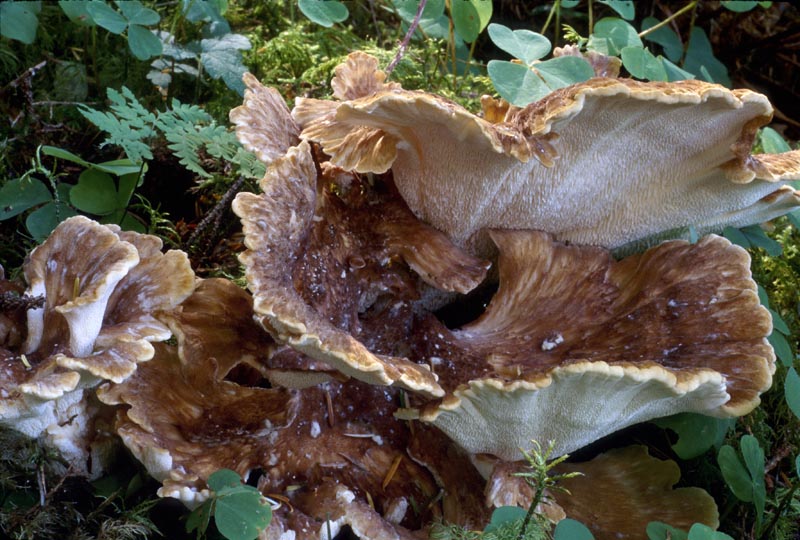
© Steve Trudell
Danny’s DNA Discoveries – Bondarzewiaceae of the PNW
by Danny Miller
|
|
Danny’s DNA Discoveries – Bondarzewiaceae of the PNW
|
|
Introduction
These related genera don't seem related at first glance. This family covers some diverse forms. Bondarzewia - stemmed orange polypore Heterbasidion - sharp margined conk Gloiodon - a fuzzy toothed crust abundant common uncommon rare - colour codes match my Pictorial Key and are my opinions and probably reflect my bias of living in W WA. Rare species may be locally common in certain places at certain times. |
|
Bondarzewia
Bondarzewia occidentalis - This stemmed polypore, not related to most other polypores, is recognized by having a stem, being thick fleshed, growing in clusters or rosettes at least near wood if not touching it and being brown to orange-brown on the cap when fresh and white in the pores. Large - each can be up to 25 cm across. Long incorrectly called Bondarzewia mesenterica, Bondarzewia montana or Bondarzewia berkeleyi, it was learned in 2016 that the west coast has our own genetically distinct conifer species. Even though most polypores are found in other orders, the Russulales have a bunch of colourful, thick-fleshed stemmed polypores in their order, mostly in the Albatrellaceae. Bondarzewia occidentalis © Steve Trudell |
|
Heterobasidion
Conks usually found towards the bottom of the tree trunk, with a sharp margin, dark brown cap and white pores that glance (go back and forth from dull to lustrous as you rotate the conk in the light). Easily 15 cm across or more. They have incorrectly been called Heterobasidion annosum, a European species. Most likely to be mistaken for Fomitopsis, a "true" polypore. Heterobasidion occidentale CA - found only in western North America usually on pine, true fir, Douglas fir and hemlock. Heterobasidion irregulare EU - on both coasts and usually found on pine, incense cedar, juniper and maybe hardwood. Collections on pine are therefore hard to tell part, but the ever so slightly larger and more irregular pores of H. irregulare may help distinguish them. The DNA of the Tibet species Heterobasidion linzhiense has been found in BC inside exotic ornamental plants that were probably from that geographical area, but it never fruited. Heterobasidion occidentale © Yi-Min Wang |
|
Gloiodon
Gloiodon occidentale BC Gloiodon strigosus EU Cool fuzzy toothed crusts. Only the locally described Gloiodon occidentale was reported from the PNW, but DNA has shown we also have the EU species Gloiodon strigosus. DNA matches within a couple of bp with most EU G. strigosus sequences. I am assuming that the species with ITS DNA >10% different than G. strigosus is our locally described G. occidentale, but it had never been sequenced before so both identities should be checked out microscopically. Gloiodon cf occidentale © Bee Marcotte Gloiodon strigosus © Steve Ness |